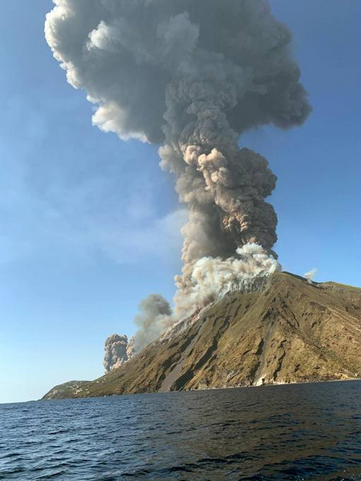The real danger is the “sphere of fire” enclosed in the crust of the volcano.
Article by MARIO TOZZI, 03 July 2019 “La Stampa“
Translated by Mirella Colalillo
Original article in Italian: https://www.lastampa.it/2019/07/03/news/stromboli-quella-finestra-aperta-nbsp-sulle-viscere-della-terra-1.36637890

Of the five hundred and more active volcanoes in the world, there is only one that can be trusted, because it has been erupting since the Sapiens crossed in the Tyrrhenian Sea and because it rarely caused pain. Even when the island became depopulated due to a stronger eruption than the others in 1930, going from 3mil inhabitants to the current 400. That volcano is Stromboli, the lighthouse of the Mediterranean. This time, though, it’s one of those. And it is also why Stromboli can be very loved or very hated, hardly its fault. It is enough to know its history, even when, as in this case, the meticulous surveillance to which the volcano is subjected has not given way to foresee a paroxysm which, it’s believed, should remain isolated.
In Stromboli, on average every 5-15 years, the paroxysmal explosive phenomena and the landslides that trigger tsunamis cause damage to people and things. Normally the Strombolian activity proceeds by modest jets of water vapor (the gas columns are white, a sign that ash is not erupted) that hurl into the air small incandescent fragments originated by the gas bubbles that arrive at the top of the magmatic column every 20 minutes or so . Sometimes the lava fountains reach a thousand meters in height and can be seen from far away, especially at night when other landmarks are missing. For this reason Stromboli is the lighthouse of the Mediterranean, known by Greeks and Phoenicians, by Romans and Punic people, as a friend.
The volcano has been more or less the same for at least ten thousand years, but its history begins with the activity of Strombolicchio (the rock in front of Stromboli, remnant of a volcanic chimney) about 200,000 years ago and continues with four eruptive periods. One hundred thousand years ago there was a Paleostromboli that erupted lavas, but above all ashes, both fallen and from dangerous pyroclastic flows (burning and fast aerosols), and mudslides: no man has observed their birth up close. Subsequently the volcano produced more lavas than ashes, lavas that continued in the period immediately preceding the so-called recent Stromboli, namely that of the Sciara del Fuoco, the great landslide escarpment on the side of the volcano, and of an activity so typical that it gave its name to all similar eruptions in every part of the world (precisely “Strombolian”). Also the lavas have changed: initially they were much richer in silica, today they are more similar to basalts with high potassium contents.
As in 1879, 1916 and 1919, and also as in 1944, in 1954 and 2002, Stromboli’s paroxysms caused limited tsunamis. They are quite frequent phenomena also for the history of men: nothing to do with the gigantic tsunamis that could be caused by the collapse of the huge sub-Tyrrhenian submarine volcanoes such as Marsili, linked however to completely different dynamics and, at the moment, not dangerous. The history of Stromboli is made up of huge landslides, some explosion and collapsing waves, as well as lava fountains and gas clouds.
Stromboli concels its possible danger in its depths. If we lifted the thin superficial crust film, Stromboli would show us its heart of darkness: a superficial magma chamber brought to light by a tomography performed by the Ingv: a kind of fiery sphere of 150 meters of radius placed at about 700 m of altitude and fed by ducts that fish much deeper. What would happen if a large landslide took away an important slice of mountain and plunged it into the sea? The denudation of the hot heart of the volcano would have catastrophic consequences.
Video of the explosion a few meters away:
The volcanism of Stromboli depends on a single cause, the clash that takes place in the lower Tyrrhenian between Africa and Europe, two of the largest geological plates on planet Earth. In reality the collision has lasted for millions of years, but the collision processes between the continents are discontinuous, and the crises are linked to the slow “digestion”, on the part of the Earth’s mantle, of the African plate that knee bends just below the Aeolian islands to be reabsorbed under the European one. Efforts generated by friction trigger earthquakes ranging from twenty to over four hundred kilometers in depth. Not only: the plaque that bends finds deeper and higher temperatures and therefore melts, generating the magmas that feed the Aeolian volcanoes.
But anyone who knows Stromboli, knows that the top of the island (ie the volcano) is constantly affected by small explosions that make a lava pour out not too viscous nor too fluid along with a characteristic cloud of whitish vapor. When I climb Stromboli I trust it and we should continue to do so. Provided you do not forget that it is a volcano, a window open on the inside of the Earth. Never be afraid of a volcano, just have respect and love for Mother Earth. Despite the pain of today. –
Vocabolario – Vocabulary:
il vulcano: the volcano
l’eruzione: the eruption
i fenomeni esplosivi: the explosive phenomena
la scarpata di frana: the landslide slope
i maremoti: the tsunamis / agitated waters
l’attività stromboliana: Strombolian activity
i frammenti incandescenti: the glowing fragments
le fontane di lava: the lava fountains
le colate di fango: the mudslides
le ceneri: the ashes
le nubi di gas: the gas clouds
la nube di vapore: the steam cloud
il vapore acqueo: the water vapor
le placche geologiche: the geological plates
il mantello terrestre: the Earth mantle
il terremoto: the earthquake
fuoriuscire: to pour out
la Madre Terra: the Mother Earth
Non hai ancora comprato il mio libro? Cosa aspetti!
Clicca qui per avere uno sconto!
Haven’t you got my ebook yet? What are you waiting for?
Click here to get a discount!

